C. Litka's Blog, page 34
August 19, 2022
The Girl on the Kerb

I thought I’d do a quick update on the novel I have out for submission and am looking for an agent to represent it. I emailed out query letters, as they’re called, on the first of July to four agents, and four more on the first of August. To date, I’ve received one rejection email from the July batch. I’ve not heard from the other three, however, not hearing from agents is a common way of signaling rejection. It is a little bit early to expect anything from the four August agents. In short, no surprises here.
What is new, is that I’ve decided to change the title of the novel, from The Road to Eura to The Girl on the Kerb. This may strike you as a big change, and in a way it is. Not that the book changes any, but the way I’m going to market it going forward changes. And perhaps in the way I’m looking at.
Right off the bat, I have to say that I know that “The Girl….” has been a big thing in publishing for years, and adopting the formula, this late it that game, can be seen as eithernaive, desperate, or cynical. However, I’m doing it because, a) it actually is as descriptive of a story as the old title was, and b) I am poking a little fun at the publishing business, with this copy-cat title. Not that they’ll get it, of course, but I’m telling you that I’m well aware of how unoriginal it is, soit’sour inside joke.
However, we have to keep in mind that I’m trying to sell this story. To sell a book, you have to write a story that agents and editors believe will sell. For many writers this means looking at the books that are being published now, but which were actually purchased a year or two before. Editors may be still buying those types of stories, or they may have moved on. If you have an agent, you can probably get a good idea where the market is going, but if you don’t, it a crap shot. A crap shot I didn’t bother to roll when I wrote this story. As always, I wrote the story I felt like writing, the way I felt like writing it. Which makes it an almost impossible story to sell, because I know that I don’t write stories the way they write, and sell them, today. Heck, that's why I started writing my own stories. My only hope of selling The Girl on the Kerbis to present it as oneof those outliers, a unique book that could strike it big. Or not. That, anyway is my approach going forward. And the title, The Girl on the Kerb, represents this new approach to marketing the story.
While the story is set on Earth in the distant future, that is about the extent of its science fiction-ness. I often use science fiction settings merely as an excuse to write an old-time adventure story that allows me to have a free hand to create the world and the way it works, without having to fit it into our known history. Or do the necessary research to fit it into our known world. This novel is no different. The technology in use is little more than what we are using today, and society is very much pre-1950. I have described it as speculative fiction, but I might even drop that classification in the future, and consider it just a lighthearted novel.
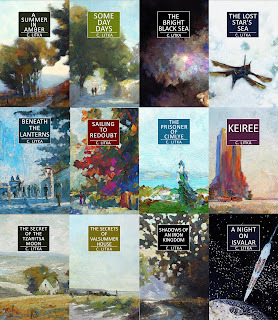
August 12, 2022
Coming This Fall -- The Aerie of a Pirate Prince
A new Nine Star Nebula Mystery/Adventure is coming this fall! I have completed the first draft of The Aerie of a Pirate Princeearlier this week. It has been a long journey.
I started writing this story on 1 November, 2021. By 17 November I was 16,000 words into it. Nearly a 1,00 words a day – a nice steady clip. However by 29 November, I had added only a thousand more words. While I had a beginning written, and an ending in mind, I realized that I was going to need something like 25-30,000 more words to fill in between the beginning and the planed ending, which I had not thought about. At least if I wanted it to be a novel. And I did. So I needed to dream up a long middle series of adventures before continuing on. Faced with this prospect, I paused writing to dream these up. However, the was another reason as well. I really wanted to write a new long, real novel. I had spent all summer trying and failing to come up with one, but I had now the inklings of how I could combine several stories to make one. So I spent the months of December and January dreaming up The Road to Eura, and began to write it on 26 January, finishing the first draft on 27 May.
After finishing the beta version of The Road to Eura, and sent it out to a traditional publisher for consideration, I returned to The Aerie of a Pirate Prince on 20 June. Realizing that the story I had in mind, was basically a novella, and that padding it to make it a novel was probably not a good idea I'm now content to publish it as a novella. Plus, if I'm to publish a book in 2022, this was likely it. The good thing is that you only need a beginning and ending for novellas.
As it turns out, my first draft weighs in at 38,800 words, which is just 1,200 words shy of a “novel” length story, for SF anyway. And given that I usually add words rather than trim them in my second and third drafts, it is possible that The Aerie of a Pirate Prince will end up a very short novel rather than a very long novella. Not that it really matters.
So what is The Aerie of a Pirate Prince about?
Rafe d’Mere and his feathered friend, Kee, return once again. The story is set three and a half years after the events recounted in Shadows Over an Iron Kingdom. d’Mere has been living the life he had originally set out to do – touring the planets of the Alantzia system at his leisure. When he tires of a planet, he signs onboard a ship as a limited time systems’ mate. The story opens with d’Mere aboard Captain Felle Sing’s Rendezvous Moon with his old pal, Chief Engineer Red Tew aboard. In Teire orbit they discover that one of the containers they off-loaded was off-loaded to the wrong lighter, though the lighter had supplied all the correct ID codes to collect the box. In short it had been hijacked. But due to an unexpected event, the original consignee learned of it arrival far sooner than what the hijackers had arranged. So, with only a four hour lead, Captain Sing, and the consignee’s office manager, Lasha Nin, are determined to track the stolen merchandise before it can be reloaded into another contain and sent off to the drifts. Red Tew volunteers to assist Captain Sing, and then volunteers d’Mere as well, pointing out that d’Mere’s an old hand at dealing with pirate princes. So once again, d’Mere is dragged into dealing with yet another ruthless pirate prince.
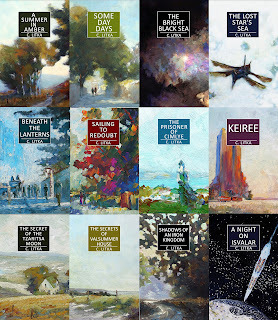
August 5, 2022
The Alloy of Law Review
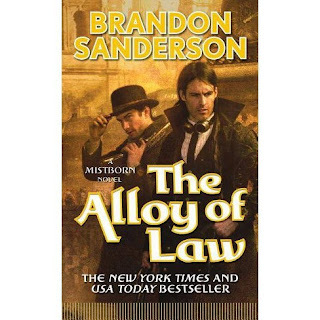
The Alloy of Law by Brandon Sanderson – C
This is the 4thbook in the Mistborn fantasy series, and the first to go under the title of the Wax and Wayne books. There are currently two other books in this series, with the last one on the way. The stories in this series are set 300 years after the original Mistborn trilogy. They feature a cowboy-like gunslinger/lawman Waxillium Ladrain, and his sidekick Wayne. The setting up has a wild west lawman inherit a title and an estate. He returns to an early 20th century type city, with some things like the beginning of electric lights and motor cars. There, he gets drawn into investigating a series of mysterious robberies.
I received this copy, like the other Sanderson title, from TOR for free. This time, no doubt to promote the release of the 4th and last book in the Wax and Wayne series in November 2022.
I did not get very far into Sanderson’s The Way of Kings, but this book was different enough for me to to finish it. It tells a less epic and more lighthearted story, which I much prefer, and features some likable characters – if you ignore the fact that Sanderson has them killing “bad guys” rather freely. Indeed, the story started out as a C+ story with potential, but lost points as it went along, for that and one related reason. That reason is that this read like a superhero comic book without the pictures. Some 30 years ago I started following some Marvel superhero comics. But that phase didn’t last all that long, as I soon grew tired of the formula: set up a conflict, stage an elaborate barroom fistfight with superpowers, leave it hanging in the balance. Resolve that cliffhanger in the next issue, set up the next reason for the next barroom fistfight with superpowers, rinse and repeat. Alloy of Law is something like those comics. It definitely is a superhero story.
Wax, Wayne, and the villain are superhero type characters in that each has different superhuman powers. Oh, Sanderson has devised an elaborate system of magic to explain these powers, but stripped of that terminology they're just like your typical collection of superheroes. The story, as I mentioned is something of a mystery, but like the comics, it usually served to set up the next superpower brawl, some of which are so elaborate that they are spread over several chapters. Remember the old adage that a picture is worth a thousand words? Well, since there are no pictures in this book, every panel of a theoretical The Alloy of Law comic book gets its thousand words. Or more. So if detailed descriptions of fights with flying people, time bubbles, and regeneration is your jam, you will likely enjoy this book. And given the popularity of Marvel movies it seems like that people do enjoy these elaborate superpower fistfights, so, if you are one of them, and can picture this type of action in your head, I dare say you will like The Alloy of Law. Even I got through the book, and while I could’ve stopped reading once I got tired of all the extended brawls, I kept on – if only because I’d have nothing to write about this week if it wasn’t The Alloy of Law.
Will I go on and read more in this series? I rather doubt it. It had an interesting world to explore, but Sanderson spent way too much time choreographing fight scenes for my taste. And heroes who shot a couple dozen people dead -- even "bad guys" without remorse, are not really my idea of heroes.
July 29, 2022
River of Stars & A Psalm for the Wild-Built Reviews
Well, that was last week, this is this week in book reading. Last week it was books written in 1922 and 1959. This week we have books written in 2013 and 2021. And what a difference it makes. The 2013 book was Guy Gavriel Kay’s River of Stars, a fantasy set in a make-believe China, and Becky Chambers’ 2021 novella, A Psalm for the Wild-Built, which TOR sent to me for free to promote its sequel. The differences between the two week’s readings are quite striking.
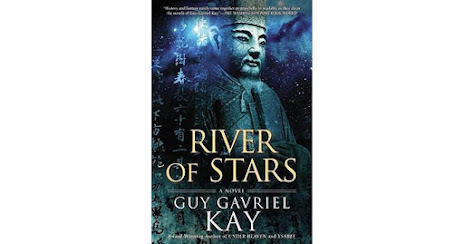
River of Starsby Guy Gavriel Kay -- DNF (13%)
Note: I believe I read this book 6 or 7 years ago, since some of the scenes I read seemed familiar and I know that I read his first book in this setting,Under Heaven. Obviously, I don’t remember if I finished it, or not, back then. However, I forget books quickly, so that not clearly remembering if I read it only means that it wasn’t one of my rare memorable books.
Well, I didn’t finish it this time. I found it to be a mess, in some of the same way as the other Kay book I attempted to read back in April, Children of Earth and Sky was. Only in more ways.
Kay writes fantasies set in knock-off historical settings, in this book in 13th century China. In both books, he introduces a lot of disposable point of view characters, tosses in a lot of rather disjointed history, and skips ahead in time briskly -- at least the beginnings. In this book, the first 13% of the book covers maybe three, four, or more years between the scattered incidents he relates. Who knows? As I said in my review of Children of Earth and Sky, I have no doubt that he will tie at least some of the point of view characters together at some point. But due to their brief, disjointed appearances, I didn’t have the time to come to care about them, and so I had no interest in learning about their future lives.
One of the YouTube booktubers maintains that Kay is the best living fantasy writer. Other readers have praised his writing as well. I’ve read so little fantasy that I can’t comment on that. What I can say is that, I didn’t see what I consider great writing in this piece. I found his sentence structure rather ill-elegant at times. His info-dumping, which he does a lot of, was disjointed and hard to follow. Sometimes he was writing in present tense, sometimes not, and he even included a passage from long after the events of the book. In short, the writing was all over the place. The YouTube fellow suggested that he was experimenting with style at this period, which may well be the case. It didn’t work for me, nor, I gather, for him as well.
My bottom line; I didn’t really get much sense of ancient China from the portion of the book I read. I have read a fair amount on China, and watched a lot of their historical fiction/fantasy TV series, so I have my own feel for China, a feeling that was missing in the portion I read. I greatly dislike the use of assorted viewpoint characters who are not on stage long enough to care about. I can’t help but think that when authors break their stories into little pieces like this, they lack the confidence in the strength of their story, and so they make it into an intellectual puzzle instead. No doubt I am wrong. Still, I like stories that unfold like real life stories do in our real lives, not viewed from the eyes of a god, or as an artifact of creative writing. That’s just me.
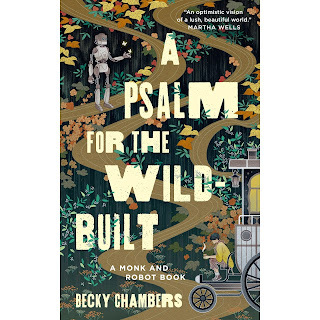
A Psalm for the Wild-Built by Becky Chambers – C
This is a novella length story is set on a moon whose industrial expansion almost destroyed its ecology. However, at some point the machines that were running the factories gained sentience, and were given their freedom, leaving human society behind. This event wrought a great changes in the society, resulting in the closing of the factories and society became much more pastoral, thus saving the moon’s environment. The story concerns a religious person named Sibling Dex who, dissatisfied with life in a monastery, decides to become a tea monk. This mission involved living a roving life, making the rounds of villages with a wagon pulled by an electric bike. In the villages Dex offers tea and comfort to people who in need a bit of both. After some years, Dex grows dissatisfied with this life as well. Wanting something more, but not knowing what, Dex sets out, on a whim, for a long abandoned monastic retreat. On the road Dex meets one of the free living robots, Splendid Speckled Mosscap, who has been tasked with seeing how the humans are faring since the sentient machines went their own way. What follows is a story of how Dex and Mosscap eventually form a friendship, despite Dex’s initial misgivings.
And what follows from that meeting and their growing discovery of each other is a philosophical exploration of… Now there you have me. I have discovered that I am not a deep thinker. I am content with the sparkling sea, with little interest or appreciation of the depths which lie beneath the waves. And so while the two discussed many various things, my interest and attention waned. You may well find their discussions quite enlightening.
Becky Chambers writes the type of stories I should like. Which is to say that she writes stories with pleasant characters in smaller settings where the universe is in no danger. I finished this story – which is more than I can say for the first book of hers I tried, A Long Way to a Small, Angry Planet, but I can’t say I was enthralled by it. It was too simple and moved too slowly even for me. And while I did finish the story I don’t think I’ll be reading is sequel.
July 22, 2022
Love on a Branch Line & Fair Harbor Reviews
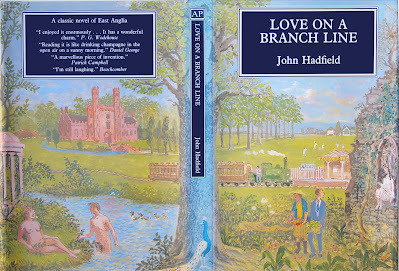
Love on a Branch Line by John Hadfield – B+
The story behind this book begins with a video on YouTube I recently started watching called “Eccentric British Comedy – parts 1 &2”( that you can find here.), and really enjoyed it – it seemed right up my alley. I stopped, oh, some 40 minutes into the show to figure out what it was I was actually watching, as the title went by without me taking much notice of it. It was Love on a Branch Line, and googling it, I discovered that it was a 1994 BBC mini-series based on a book by the same name. I googled the book, looked at its Goodreads ratings, and since P G Wodehous “enjoyed it enormously,” I decided to hold off watching the remaining hours of the TV show so I could read the book it was based on. Passing up some US paperbacks, I found the hardcover copy, the cover of which is above, at a British bookshop via ABE Books and ordered it – $20 with shipping. Well, you can’t take it with you or send it on ahead.
Love on a Branch Line is a light, humorous novel set in the English countryside of 1957. Our bureaucrat narrator. Jasper Pye, overhears his girl friend telling someone at a party that “Jasper is a bore.” Stung by this remark, he decides to quite his position to go to Paris and paint. However, he finds that his boss is sending him to investigate a remote branch of their Ministry of Information called “Output Statistics” which had been established during World War ll in a country house on the border of Suffolk and Norfolk. Since then it had more or less been overlooked. However, with budget cuts looming, his boss wants to close that branch and Pye’s report will facilitate that. Plus, it will get Pye out of the office – it being a fresh situation, since, according to his boss, they all run the very real risk “of becoming a bit of a bore.” This comment is enough to send Pye on his way to Arcady Hall.
At Arcady Hall we meet a fine cast of eccentric English characters, from the lord of the manner who bought the four mile branch line bordering his estate when it was abandoned and now lives on the train that travels back and forth each day, with one of his daughter driving it while he dines and listens to old jazz recordings on his gramophone. We meet his three daughters, each either sweet or strange, or both, the pompous Professor who runs the Office and looks after Arcady Hall as if it was his own, along with an assistant deeply into cricket, and a secretary, plus various other local “characters.” Pye finds that he’s rather fallen down a strange rabbit hole – to a place where people don’t find him a bore. And so, over the course of a long weekend, he kisses and makes love to some of the daughters, plays some cricket, and undertakes various duties at the village fete for “fallen women.”
While the writing might not quite be up to Wodehouse’s, the story is sweet and strange, and nostalgic, probably even when it was written in 1959 – a story set in the long lost never-never-land of the English countryside. For a fan of Wodehouse, Miss Read, and D E Stevenson, it is a story, as I said, right up my alley. So now, I have the BBC mini-series to finish. What I saw of it was very faithful to the book, so I have high hopes.
As it turned out, I read two books this week, since Love on a Branch Line arrived from England far earlier than I had expected. Here is the first book I read.
Fair Harbor by Joseph C Lincoln – B+
I don’t like to travel, but I do like to visit places virtually. I’ve traveled (virtually) all over Europe in the cabs of trains with videos posted on YouTube. Books will take me to places as well. And I think each summer, I get the urge to visit Cape Code. And the author that takes me there, across a thousand miles and a century or more is Joe Lincoln. I’ve already posted a blog post about my collection of Joe Lincoln books here. So I won’t say more than this summer I visited Cape Code in the form of his 1922 novel Fair Harbor – for perhaps the third time.
It is one of his better ones, with all sorts of “characters” – which are a hallmark of his writing. The story concerns a disabled sea captain who is talked into overseeing a home for the widows and the unmarried sisters of mariners, in order to preserve the home from the recently widowed husband of the home’s founder. The judge who oversees the operation of the home is now close to death and fears that after spending his late wife's fortune and now likely destitute the widowed husband will seek to spend the endowment that pays for this home .He wants someone like Captain Kendrick in charge to prevent this from happening. The home is managed by a widow, though her daughter, the love interest, is the person who does all the real work looking after the place and residents. We meet the lady inhabitants of Fair Harbor, Judah, one of his old sea-cooks who’s always singing sea chanteys, the smooth-talking widower, and a host of other citizens of Cape Code in the 1870’s over the course of the story that winds its way to a happy ending, as all Joe Lincoln books do.
I like small stories of everyday life in another time and place laced with romance and humor. I read for escape, and when summer rolls around, its to a quint, long gone Cape Code that I like to spend some hours visiting – and revisiting.
Long story short, it was a good week for reading, having read two books that suit my taste very well this week.
July 15, 2022
What's Next & When
In the Guy & Molly story, Sian I had Guy and Molly going back to the non-conforming society that Guy had escaped from in his youth, though, of course, 700+ Marian years had now passed since he left it. He felt the need to rediscover his roots and to see if the decedents of the family he left behind still existed. I had something of a story in my head, but couldn’t get it to the point where I was excited to write it.
I ran into a similar problem with the Rafe D’Mere’s story. I had the beginning – all 17,000 words of it – written, and I had a definite ending in mind… But I then realized that I needed to come up with some 20,000 words to fill the middle of the story before the ending I had in mind -- if I wanted it to be a novel. And I did. I didn’t have 20,000 words worth of ideas readily on hand to do that, so I had to stop and try to dream up enough action to write about to fill the needed 20,000words to get me to the ending I had in mind, which was a too daunting task.
So I shelved that idea as well, and instead, returned to my summer project with some new ideas that eventually turned into The Road to Eura, my 2023-24 novel.
So here we are. What's next? I recently watched an interview with the SF and fantasy author Adrian Tchakovsky. During that interview he said that he could write a novella in a month, because a novella requires only a beginning and an ending, thus avoiding the long, hard slog through the middle to make a novel. It seems that if I’m to self-publish anything in 2022, I'm going to have to take that approach to heart. So, any port in a storm – or a story – it’s going to have to be a novella this year.
And with both the beginning written, and the ending planned, that novella it is going to have to be the Rafe D’Mere story. At present, I have almost 24,000 words written, and have reached the beginning of the ending of The Aerie of a Pirate Prince. Now I only have to try to recall how I had that ending working out… The details are long gone. But I still have the twist, so it is mostly just a matter of choreographing action – which I hate doing. Still, I think I am not going out too far on a limb to say that I should be able to come up with another 10,000 to 12,000 words for a nice fat novella. And that I should be able to completed it within the next two months. All I really need to do is get excited about it, think about it, and then finish it. Stay tuned.
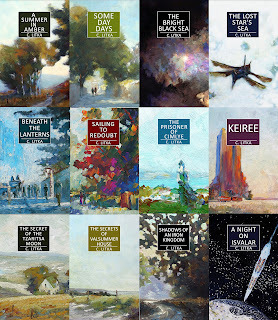
July 8, 2022
Audiobooks & Other Stuff
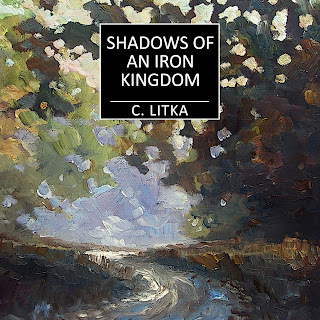 A sample of the square cover of my audiobooks
A sample of the square cover of my audiobooksNothing much to say this week, so I’ll just take this opportunity to update you, dear reader, on how my various projects are going.
At the beginning of May (2022) I started offering all my ebooks on the Google Play Store as audiobooks as well. As part of a beta program, Google offered to convert the ebooks I was selling through Google into audiobooks, for free. I took them up on their offer. It has proved to be a pretty darn good move on my part.
Though I only have 12 ratings so far on my audiobooks, the average is 4.4, which tells me that the audio component of the audiobooks has not been a hindrance to their enjoyment. Which is great. The fact that the stories are auto-narrated by Google’s AI technology, not a person, does not seem to be an issue. Seeing that all my books are first person narrations, having one fairly expressive voice read the book would seem to be the natural way to do it anyway. I’m not a audiobook “reader”, but I have sampled some, and have heard narrators reading different characters using different voices, and found it to be distracting, and in one case, rather goofy. So, all in all, I think that, at least for my books, the auto-narration works. Plus, Google has said that it will only improve over time. So, as I said, I’m quite happy.
The other bright spot in adding audiobooks to the mix has increased my sales significantly. To date I’ve sold (for free) 1,880 audiobooks in a little over two months. And last month (June), my combined ebook and audiobook sales from all my sales venues came in at 2,071 books. To put that number in context, that is around 25% of my best annual sales – in just one month. Now, I expect these numbers will trail off. They always do. But I believe that this experiment demonstrates that it pays to innovate when you see an opportunity.
I should note that my business model is designed to get my books into the hands of readers, not to make money -- while not spending money to do so. To that end, I produce and sell all my books for free, when possible. While compared to popular indie authors, my numbers may not be all that impressive, I've sold something like 53,000 books without any marketing effort or losing any money doing so.
My next experiment is submitting my newest novel, The Road to Eura, to the SF publisher Gollancz during a rare open submissions window. I am also querying agents to see if they would like to represent it and sell it to other traditional publishers. It’s a long term project – I’m querying only four agents a month – and I am keeping my expectations well in hand.
The last bit of news is that I’m hoping to be able to offer a new Nine Star Nebula Mystery/Adventure story, The Aerie of a Pirate Prince, sometime early this fall. I’m nearly 20,000 words into the story and I suspect that it will clock in as a novella rather than a full novel, so I’m likely more than halfway done with it. It features Rafe D’Mere, along with his crow companion Kee, in another reluctant run-in with a pirate prince. Stay tuned.
Audiorbooks & Other Stuff
 A sample of the square cover of my audiobooks
A sample of the square cover of my audiobooksNothing much to say this week, so I’ll just take this opportunity to update you, dear reader, on how my various projects are going.
At the beginning of May (2022) I started offering all my ebooks on the Google Play Store as audiobooks as well. As part of a beta program, Google offered to convert the ebooks I was selling through Google into audiobooks, for free. I took them up on their offer. It has proved to be a pretty darn good move on my part.
Though I only have 12 ratings so far on my audiobooks, the average is 4.4, which tells me that the audio component of the audiobooks has not been a hindrance to their enjoyment. Which is great. The fact that the stories are auto-narrated by Google’s AI technology, not a person, does not seem to be an issue. Seeing that all my books are first person narrations, having one fairly expressive voice read the book would seem to be the natural way to do it anyway. I’m not a audiobook “reader”, but I have sampled some, and have heard narrators reading different characters using different voices, and found it to be distracting, and in one case, rather goofy. So, all in all, I think that, at least for my books, the auto-narration works. Plus, Google has said that it will only improve over time. So, as I said, I’m quite happy.
The other bright spot in adding audiobooks to the mix has increased my sales significantly. To date I’ve sold (for free) 1,880 audiobooks in a little over two months. And last month (June), my combined ebook and audiobook sales from all my sales venues came in at 2,071 books. To put that number in context, that is around 25% of my best annual sales – in just one month. Now, I expect these numbers will trail off. They always do. But I believe that this experiment demonstrates that it pays to innovate when you see an opportunity.
I should note that my business model is designed to get my books into the hands of readers, not to make money -- while not spending money to do so. To that end, I produce and sell all my books for free, when possible. While compared to popular indie authors, my numbers may not be all that impressive, I've sold something like 53,000 books without any marketing effort or losing any money doing so.
My next experiment is submitting my newest novel, The Road to Eura, to the SF publisher Gollancz during a rare open submissions window. I am also querying agents to see if they would like to represent it and sell it to other traditional publishers. It’s a long term project – I’m querying only four agents a month – and I am keeping my expectations well in hand.
The last bit of news is that I’m hoping to be able to offer a new Nine Star Nebula Mystery/Adventure story, The Aerie of a Pirate Prince, sometime early this fall. I’m nearly 20,000 words into the story and I suspect that it will clock in as a novella rather than a full novel, so I’m likely more than halfway done with it. It features Rafe D’Mere, along with his crow companion Kee, in another reluctant run-in with a pirate prince. Stay tuned.
July 1, 2022
The Making of The Girl on the Kerb -- Part 2

This is the second installment of my series “The Making of The Girl on the Kerb”. The post below contains the first installment, if you haven’t read it and are curious.
In my first installment, I explained that I liked the idea of setting a story in an early to mid 20th century society, with a super-advanced civilization buried beneath their feet. This allowed for the prospect that some of that civilization’s technology might have been dug up and gotten to work – in the hands of an ambitious leader who intends to use it to expand his or her power.
I had several versions of this story partially written in my head, but the only one that made it as far as 4.000 words on a screen; a story I called Rust in the Dust.
But first more on the premise.
The setting for all these stories would be Europe united under one weak king, but divided into provinces, each with small regiment or two that could be called on to defend Europe, if necessary. For the story, I had one those provincial leaders determined to expand his domain at the expense of his neighbors. While he may have some allies, most of the provinces would, in theory, unite their regiments to stop any such move. This prospect, however, did not seem to deter this leader, leading the other leaders to suspect and fear that he/she had found a working device from the ancient tech age that could be used in a war, which would make all the difference.
The story would then involve amateur agents being sent into this province to discover what exactly its leader had found and how they were planning to use it. It would have been a story of travel and intrigue with these agents following clues and local rumors of mysterious going doings to discover the leader’s secret. There is a Sax Rohmer book called The Day The World Ended that is a partial inspiration for this story, at least for mood.
In some versions the war was just looming. In others I had “air pirates” of an unknown origin already attacking provincial air bases, calling to mind the summer of 1940 in Britain. In most stories an archaeologist, familiar with advanced technology form the past, is the narrator. In one, I had him drafted into the army and assigned to investigate crashed aircraft for clues as to their origin. In all he would serve as narrator, with the other agent more politically connected serving as the female/romantic co-star. For a number of these stories I had at least the first couple of chapter in mind, but I only have Rust in the Dust got some words on a screen.
So why did these variations on a theme fall apart?
The first reason is that, though I was attracted to the mood of those times, I don’t really like writing dark, serious, or sad stories. And though looking back on those historic times one can get a sense of romance – of being part of a special time, in reality, it was probably anything but romantic, so that it would be hard to write a story that was both realistic, and romantic.
Secondly, a more practical road block: I could not come up with a technology that would fit the bill for the story. What could be dug up and used to dominate the world? A giant robot? A flying machine? Battle tanks? What would be cool, and clever, and make the leader invincible?
And then, if I managed to come up with some sort of cool, invincible technology, how would I then make it so that it could be defeated by our heroes? Not impossible – many stories do that. But I like to write realistic stories with grounded, everyday heroes, which makes it a lot harder...
Which brings me around to my last issue, which is that I don’t like writing stories where my characters have to save the world. I like smaller, more personal stories. So, when it came right down to it, I simply could not stay excited about the whole concept.
And yet, in the end, many of these elements and settings ended up being tweaking to play a large part in the setting of The Girl on the Kerb.Still, it would take parts from two other failed story attempts to create a story that I could write all the way to the end. I think it turned out pretty good, but you’ll have to take my word on that for a little while.
In any event, I will talk about the next failed project that contributed to The Girl on the Kerb in the next installment of this series, at some future date, to be determined, i.e. when I can think of nothing else to write about.
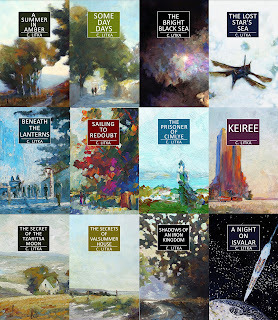
The Making of The Road to Eura -- Part 2
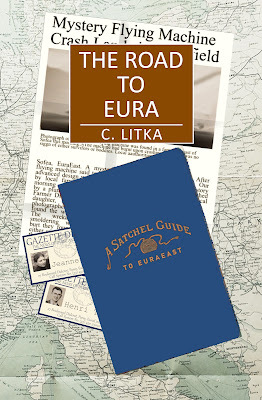
This is the second installment of my series “The Making of The Road to Eura”. The post below contains the first installment, if you haven’t read it and are curious.
In my first installment, I explained that I liked the idea of setting a story in an early to mid 20th century society, with a super-advanced civilization buried beneath their feet. This allowed for the prospect that some of that civilization’s technology might have been dug up and gotten to work – in the hands of an ambitious leader who intends to use it to expand his or her power.
I had several versions of this story partially written in my head, but the only one that made it as far as 4.000 words on a screen; a story I called Rust in the Dust.
But first more on the premise.
The setting for all these stories would be Europe united under one weak king, but divided into provinces, each with small regiment or two that could be called on to defend Europe, if necessary. For the story, I had one those provincial leaders determined to expand his domain at the expense of his neighbors. While he may have some allies, most of the provinces would, in theory, unite their regiments to stop any such move. This prospect, however, did not seem to deter this leader, leading the other leaders to suspect and fear that he/she had found a working device from the ancient tech age that could be used in a war, which would make all the difference.
The story would then involve amateur agents being sent into this province to discover what exactly its leader had found and how they were planning to use it. It would have been a story of travel and intrigue with these agents following clues and local rumors of mysterious going doings to discover the leader’s secret. There is a Sax Rohmer book called The Day The World Ended that is a partial inspiration for this story, at least for mood.
In some versions the war was just looming. In others I had “air pirates” of an unknown origin already attacking provincial air bases, calling to mind the summer of 1940 in Britain. In most stories an archaeologist, familiar with advanced technology form the past, is the narrator. In one, I had him drafted into the army and assigned to investigate crashed aircraft for clues as to their origin. In all he would serve as narrator, with the other agent more politically connected serving as the female/romantic co-star. For a number of these stories I had at least the first couple of chapter in mind, but I only have Rust in the Dust got some words on a screen.
So why did these variations on a theme fall apart?
The first reason is that, though I was attracted to the mood of those times, I don’t really like writing dark, serious, or sad stories. And though looking back on those historic times one can get a sense of romance – of being part of a special time, in reality, it was probably anything but romantic, so that it would be hard to write a story that was both realistic, and romantic.
Secondly, a more practical road block: I could not come up with a technology that would fit the bill for the story. What could be dug up and used to dominate the world? A giant robot? A flying machine? Battle tanks? What would be cool, and clever, and make the leader invincible?
And then, if I managed to come up with some sort of cool, invincible technology, how would I then make it so that it could be defeated by our heroes? Not impossible – many stories do that. But I like to write realistic stories with grounded, everyday heroes, which makes it a lot harder...
Which brings me around to my last issue, which is that I don’t like writing stories where my characters have to save the world. I like smaller, more personal stories. So, when it came right down to it, I simply could not stay excited about the whole concept.
And yet, in the end, many of these elements and settings ended up being tweaking to play a large part in the setting of The Road to Eura.Still, it would take parts from two other failed story attempts to create a story that I could write all the way to the end. I think it turned out pretty good, but you’ll have to take my word on that for a little while.
In any event, I will talk about the next failed project that contributed to The Road to Eura in the next installment of this series, at some future date, to be determined, i.e. when I can think of nothing else to write about.




